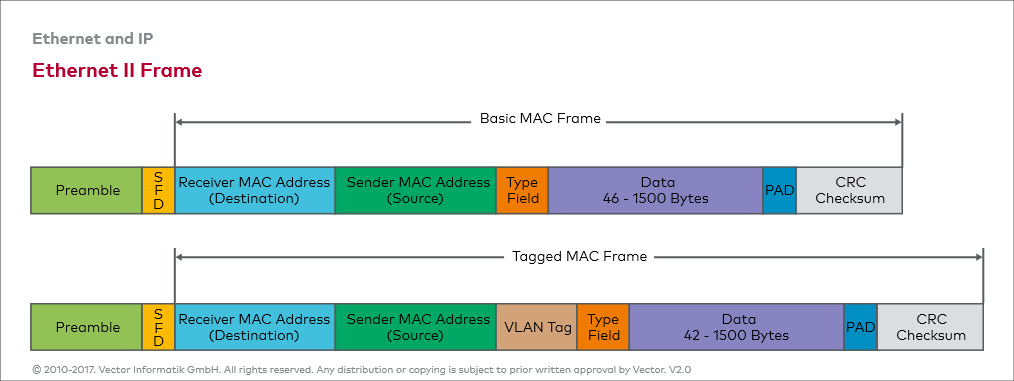Ethernet Frame
Basic and tagged frame
The IEEE specifications define different formats for Ethernet frames. The automotive industry typically uses the Ethernet II frame, which can also contain information for VLAN as an extension. For this reason, a distinction is made between the basic MAC frame (without VLAN) and the tagged MAC frame (including VLAN).
MAC addresses
An Ethernet II frame generally begins with a receiver or destination address. This specifies which network nodes are to receive a message. In contrast to the subsequent sender or source address, besides Unicast addresses, it is also possible to use Multicast or Broadcast addresses. For an Ethernet frame, there can be only one sender but multiple receivers.
Ether type
The basic and tagged MAC frames are differentiated with the type field (Ether Type). This generally identifies the contained packet in the payload data area and gives information about utilized protocols in the higher layers (e.g., IPv4). If the Ether Type has a value of 0x8100, the type field is shifted rearward four bytes and a VLAN tag is inserted at its original position.
VLAN tag
A VLAN tag consists of a protocol identifier (TPID) and control information (TCI). While the TPID contains the value of the original type field, the TCI consists of a Priority (PCP), a Drop Eligible or Canonical Form Indicator (DEI or CFI), and an Identifier (VID). Identifier and Priority are mainly used in the automotive industry. The Identifier distinguishes the respective virtual network for the different application areas. The Priority allows optimization of run-times through switches so that important information is forwarded preferentially.
Payload
Following the type field, the Ethernet II frame contains the payload data area. The payload has a minimum length of 46 bytes without VLAN tag or 42 bytes with VLAN tag. It can contain up to a maximum of 1500 bytes in the automotive industry.
CRC checksum
A CRC checksum is transmitted at the end of the Ethernet II frame. The value contained in the checksum is calculated using a standardized algorithm that is implemented the same way in the sender and receiver. The calculation is made with all fields of the Ethernet II frame and therefore assures the integrity of the entire message.
Ethernet packet
For transmission of the Ethernet II frame, an Ethernet controller inserts a preamble and a Start Frame Delimiter (SFD) at the beginning. Historically, these serve to signal the start of the transmission. The combination of preamble, Start Frame Delimiter, and Ethernet II frame is referred to as the Ethernet packet.



